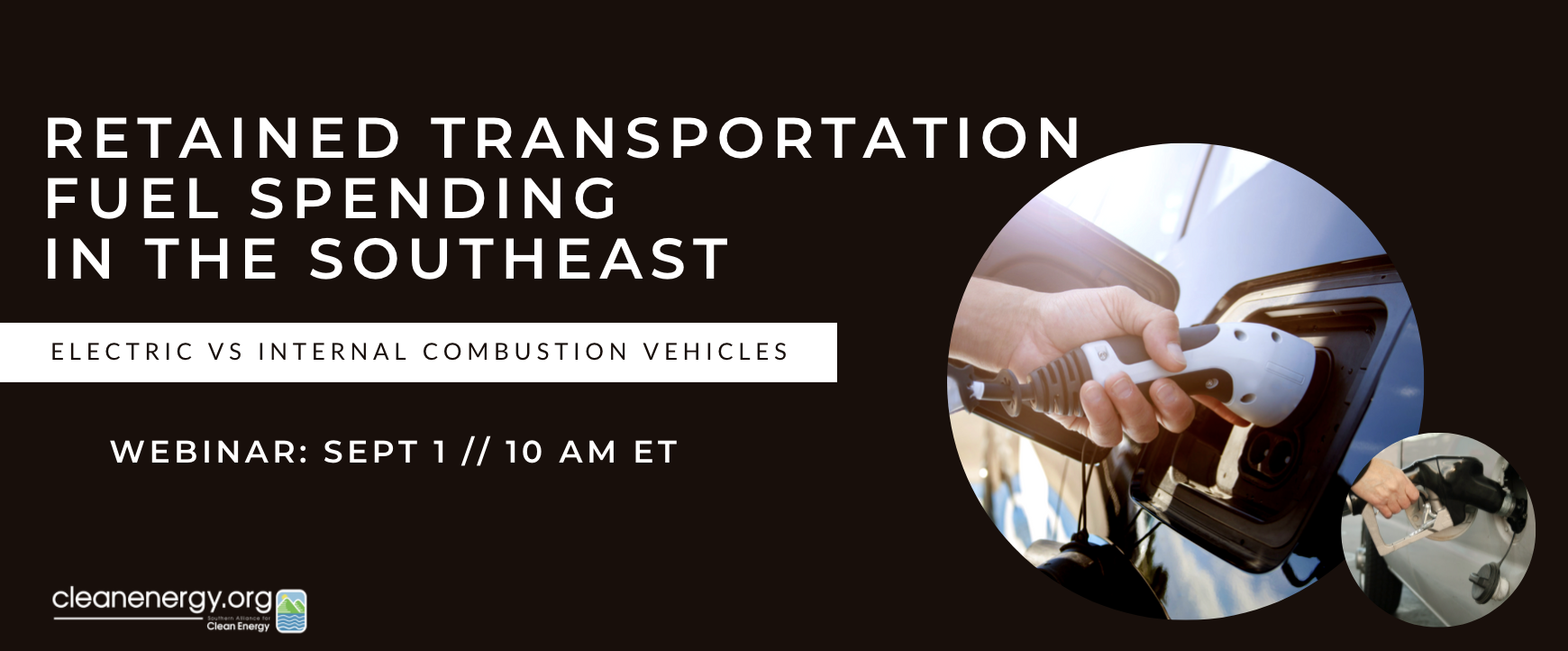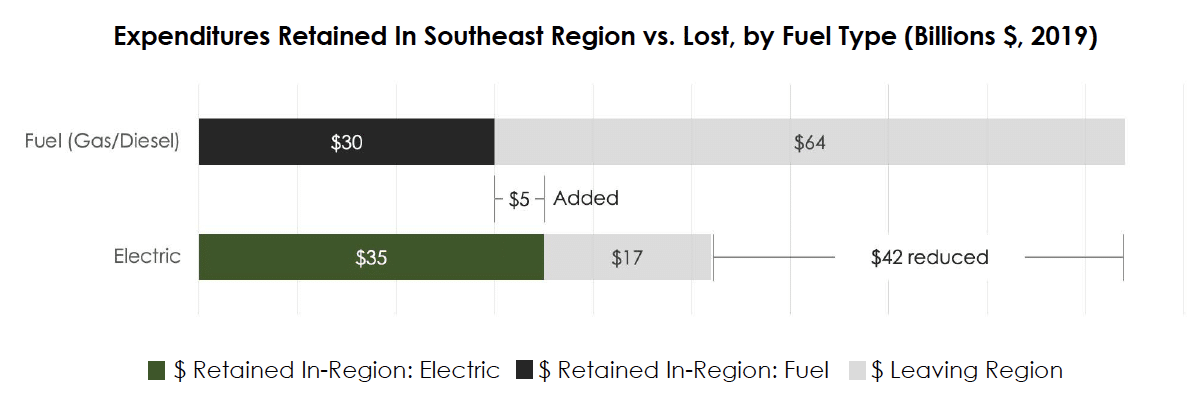Because most electricity is generated locally, shifting to electric transportation will save consumers money at the plug and keep more of their transportation fuel dollars recirculating through local economies.
Stan Cross and Heather Pohnan | August 26, 2021 | Clean Transportation, Electric Vehicles, Energy PolicyElectrifying transportation could provide an economic boon for Alabama, Georgia, Florida, North and South Carolina, and Tennessee. That’s what the Southern Alliance for Clean Energy (SACE) reveals in a new analysis, “Retained Transportation Fuel Spending in the Southeast: Electric vs. Internal Combustion Vehicles.”
SACE analyzed how much consumers spend on gas and diesel, how much of that transportation fuel spending remains in a given Southeast state, and how much leaves. The analysis then looked at what happens if all on-road gas and diesel-powered cars, trucks, and buses are replaced with vehicles that drive entirely on electricity.

Download the Report
Watch the Report Webinar
What We Found: $47 Billion on the Table
Fueling transportation is expensive
Southeast consumers spend approximately $94 billion on gas and diesel fuels annually. And because the region has nearly no oil production or refining operations, only about one-third of that amount — approximately $30 billion — is retained in our region’s economy, and the rest leaves to pay for the imported fuels. That adds up to $64 billion leaking out of our region’s economy every year.

Electrifying transportation could patch the leak
As light, medium, and heavy-duty vehicle electrification accelerates, more efficient vehicles and cheaper in-state-generated electricity allow consumers to spend less to drive the same number of miles. If all of the region’s vehicle miles traveled were electric today, Southeast consumers would spend approximately $52 billion on electricity, reducing consumer transportation fuel spending by $42 billion annually.
Extra spending kept in the Southeast by electrifying transportation
Additionally, more than two-thirds of those $52 billion dollars we would spend on electricity for transportation — approximately $35 billion — would stay in the region, vs. the $30 billion we retain under the current system that relies heavily on gas and diesel. This means that we could keep an additional $5 billion annually recirculating through and supporting local economies if we switched to a fully electric transportation system.
By saving consumers $42 billion in fuel spending and keeping an extra $5 billion in-region, electrifying transportation in the Southeast would result in $47 billion in transportation fuel spending retained annually.
Why it matters: Economic Impacts Should be Considered in Policy and Regulatory Actions
Our goal in conducting this analysis is to broaden policymakers,’ utility regulators,’ and industry stakeholders’ views of transportation electrification costs and benefits, stimulate discussion and spur additional research.
It is increasingly understood that electrifying America’s car, truck, and bus fleets will require federal, state government, utility, and private investment. And a lot of it. That is evidenced by the billions of dollars earmarked in the federal infrastructure bill; the $93 million of EV-related Volkswagen Settlement funds spent to date by Southeast states; the over $189 million invested and proposed by Southeast utilities; and the more than $30 billion of auto industry investment in passenger EVs alone.
The Southeast clearly has a lot to gain by distancing itself from imported gas and diesel and embracing locally-generated electricity to power transportation. Such an embrace will result in even greater payback over time as the region, which basks in sunshine, ramps up utility-scale and distributed solar generation, allowing even more dollars to be retained and invested in local economies and local jobs. As those retained dollars recirculate through local economies, they will create a multiplying economic impact.
And then there are the jobs. Collectively, Alabama, Georgia, Florida, North and South Carolina, and Tennessee make up 18% of the nation’s population. These states have secured 18% (7,785) of EV jobs, and an outsized 37% ($11.2 billion) of national EV investment. And it’s important to remember that beyond direct EV jobs are all the supply chain jobs, including mineral mining, battery production, charging infrastructure manufacturing and installation, and industry research and development, which are all present in the region and prepared to grow.
State policymakers and utility regulators need to understand what is at stake. We need a strong EV market to retain billions of dollars in transportation fuel spending and support continued regional EV industry job growth. To foster a strong EV market, we need favorable policies and regulatory reforms.
Policies like the Transportation Climate Initiative, Zero Emission Vehicle standards, and the Advanced Clean Truck and Omnibus rules, as well as the allowance for EV manufacturers to sell their products directly to consumers are all examples of levers that can be pulled to enable consumers and fleet operators to access EVs, generate revenue to support state programs, improve public health, and cut carbon emissions – and ultimately help our region maintain competitiveness.
Utilities and regulators are beginning to propose and approve more ambitious electric transportation investments, but the Southeast currently represents just over 4% of utility EV investment nationwide. Utilities have the capacity to spur EV charger deployment, support school, and transit bus electrification, and educate consumers at scale. And doing so is in the utilities and ratepayers’ best interests: EVs will create new electricity demand, which in turn will increase utility revenue, and at the same time put downward pressure on utility rates. Utilities are also positioned to ensure EV investments are equitable and reach traditionally marginalized and underserved communities.
The Southeast transportation electrification equation is becoming clearer: favorable policies + regulatory reforms = $47 billion in annual retained transportation fuel dollars and thousands of jobs. Policymakers, regulators, and industry stakeholders need to continue unpacking the costs and benefits. Clearly, there are significant financial investments needed to electrify the movement of people, goods, and services. But the economic returns to be gained are significant and favorable.
Download the Report
Watch the Report Webinar
Electrify the South is a Southern Alliance for Clean Energy program that leverages research, advocacy, and outreach to promote renewable energy and accelerate the equitable transition to electric transportation throughout the Southeast. Visit ElectrifytheSouth.org to learn more and connect with us.